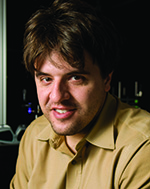December 20, 2010 - By Bruce Goldman

Karl Deisseroth
Optogenetics, a precise new way for researchers to analyze the brain circuits underpinning mammalian behavior, has been named “Method of the Year” in the issue of Nature Methods published online Dec. 20. A seminal player in the development of this new tool is Karl Deisseroth, MD, PhD, associate professor of bioengineering and of psychiatry and behavioral science at the Stanford University School of Medicine, who has a commentary on the subject in the same issue of the journal.
Neuroscientists are keen on gaining a better understanding of the biological basis of severe mental disorders such as depression, autism and schizophrenia. But researchers have been frustrated by the imprecision of existing technologies for probing the brain’s circuitry.
Optogenetics provides a solution. Deisseroth has been a leader in developing this technique, which enables scientists to cause specific sets of nerve cells in a living, freely moving animal’s brain to fire. One key advance was finding a way of bioengineering targeted cells of interest — and only those cells — so that they can be stimulated with pulses of laser light delivered via optical fibers.
Deisseroth’s group has found ways to deliver photosensitive molecules called opsins to mammalian nervous tissue so that they appear only on the surfaces of nerve cells of particular interest to a given study. Armed with this methodology, scientists have been able to systematically identify distinct brain circuits that play important roles in sleep disorders, schizophrenia, Parkinson’s disease and more.
For example, in a study published earlier this year in Nature, Deisseroth’s group and colleagues at the University of California-San Francisco unraveled the workings of two nerve-cell circuits crucial to controlling voluntary movement and showed that one of the two circuits facilitates normal movement, while the other inhibits it. The activity of both circuits, which are located deep within the brain, is ordinarily modulated by input from another set of dopamine-secreting nerve cells, which are lost in Parkinson’s disease.
The researchers showed that by stimulating one of the two opposing circuits, they could restore normal movement in mice even after destroying the dopamine-secreting nerve cells just upstream that normally drive this activity. This finding could have therapeutic implications for Parkinson’s patients. It implies that their conditions may benefit from new drugs that might be able, unlike current treatments, to stimulate the circuit that facilitates movement but not the circuit that inhibits it.
Deisseroth’s commentary cautions, “The most fundamental impact of optogenetics, even in human health, does not arise from direct introduction of opsins into human tissue” — which would require gene therapy, with all the risks it entails — “but rather from use as a research tool to obtain insights into complex tissue function, as has already been the case for Parkinson’s disease.”
Having successfully pieced together the numerous elements necessary to make optogenetics work smoothly, Deisseroth’s team has continued to refine it, make it user-friendly and disseminate it far and wide. “There have been remarkable improvements ... in the strategies to express genes in cells of interest in living organisms as well as in the ... technologies used to measure the biological effects induced by optogenetics,” state the editors of Nature Methods in explaining why 2010 is the year to honor optogenetics. The technology is now in use in at least 800 labs worldwide, and scientists come from around the globe for training sessions hosted on a regular basis in a dedicated facility near Deisseroth’s laboratory at Stanford.
What’s more, the technology promises to throw light on the workings of organs as diverse as the heart, pancreas and immune system. “Although it arose from neuroscience,” Deisseroth writes in his commentary, “optogenetics addresses a much broader unmet need in the study of biological systems: the need to control defined events in defined cell types at defined times in intact systems.”
Stanford’s Department of Bioengineering is jointly supported by the School of Medicine and the School of Engineering.
About Stanford Medicine
Stanford Medicine is an integrated academic health system comprising the Stanford School of Medicine and adult and pediatric health care delivery systems. Together, they harness the full potential of biomedicine through collaborative research, education and clinical care for patients. For more information, please visit med.stanford.edu.